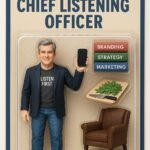Understanding Podcast Marketing Through The Power of Strategic Content Creation
Since 2009, I’ve invested 10-15 hours weekly in content creation through blogging. This consistent effort wasn’t just about sharing insights—it was a deliberate strategy to showcase my consulting expertise and attract ideal clients.
When podcasting emerged as a powerful medium, I faced a familiar question many professionals encounter: Should I expand into this new channel? I ultimately chose to focus on writing, but my experience advising numerous podcasters has revealed a universal truth:
Success in content creation—whether through blogs or podcasts—stems from crystalline clarity about your endgame.
This clarity becomes your north star, guiding every marketing decision and resource allocation.
I believe I am a successful blogger because I don’t quit. I’m persistent.
I have written over 1,800 posts and shared them consistently weekly on LinkedIn and with my subscribers. Although my audience was small for several early years, I thought my content would reach the right audience over time, and I didn’t quit.
I didn’t need hundreds or thousands of clients; I needed just a few quality prospects who could afford to hire me and would benefit from my experience and knowledge.
My audience development focuses on quality, not quantity, because I’m not building a mass audience. This marketing strategy for blogging applies to podcasting, too.
The Critical First Decision: Defining Your Podcast’s Purpose
Before investing in equipment or scheduling your first guest, you must make a fundamental choice:
Are you building for reach or resonance?
This decision shapes every aspect of your podcast’s development.
The Mass Market Approach
If you aim to build a large audience for advertising revenue, you’re essentially creating a media company. This path demands:
- Substantial upfront investment in production quality
- Unwavering commitment to consistent content delivery
- Skillful balance of broad appeal and niche focus
- Sophisticated analytics and metrics tracking
- Robust advertising operations infrastructure
The Professional Platform Strategy
If you’re leveraging your podcast to enhance your professional practice, you’re building a thought leadership platform. This approach requires:
- Clear demonstration of deep expertise
- Strategic selection of high-caliber guests
- Premium production values that reflect your professional brand
- Content that aligns precisely with your service offerings
- Focused development of your professional ecosystem
Twelve Growth Strategies for Purposeful Expansion
The following ideas have been helpful to clients I have advised. I’m sharing them with you so your podcasting can help you achieve the results you aspire to achieve.
- Promote Your Services within Your Podcast
The best podcasters offer short commercials within their podcasts about their professional services. Whether at the beginning, middle, or end, your audience needs to know that you are available to speak, offer coaching, or that listeners can take online classes.
I add a simple CTA (call to action) at the end of every blog I write.
Are you doing this effectively on your podcast? If not, why not experiment with it? Make it easy for listeners to hire you. Remind your readers about your services.
Here is my message in every post.
Connect with Jeff at The Marketing Sage Consultancy. Interested in setting up a call with me? Use my calendly to schedule a time to talk. The call is free, and we can discuss your brand and marketing needs. If you want to learn more about my new offering, The Trusted Advisor Board, you can click here to learn the details. Feel free to email me at jeffslater@themarketing sage.com or text 919 720 0995. Thanks for your interest in working with The Marketing Sage Consultancy.
2. Strategic Guest Curation
Your guest selection should reflect your podcast’s purpose. Professional platform builders should prioritize guests who occupy adjacent spaces in their industry, creating natural cross-pollination opportunities. Mass-market players should seek guests with substantial existing audiences who align with their content themes.
If you are focused on building a professional platform, your guests can represent specific audiences, demographics, or personas you want to reach. If you want to be hired by people within a specific vertical or who work in a particular industry or department, find people who represent that audience.
3. Content Atomization
Transform each episode into multiple content pieces:
- LinkedIn articles that deep-dive into key insights
- Social media threads highlighting compelling moments
- Video clips showcasing pivotal discussions
- Newsletter expansions of core themes
Professional platform builders should emphasize LinkedIn and industry publications, while mass-market players should focus on broader social channels. For over a decade, I have posted my blog on LinkedIn and tagged people I think would find the topic interesting. I aim to engage my followers, who might read my work and hire me to help them.
This strategy takes time, but it has worked for my marketing consultancy. It can also work for professional services platforms (coaching, training, leadership, etc.).
4. Platform Mastery
Rather than dispersing energy across every platform, dominate where your intended audience congregates. Professional service podcasters should focus on LinkedIn and industry forums, while mass-market podcasts require a strong presence on Instagram, TikTok, and YouTube. Pick one social media platform and invest your time and energy in mastering it. Don’t spread yourself too thin.
I’d love to have a video presence on YouTube or TikTok, but I’m seeing results from blogging and sharing my content on LinkedIn. I also only want to spend 10-15 hours weekly on marketing, as my practice keeps me busy.
Podcasters should consider creating “trailers” or audiograms that allow prospects to sample your work in 15 seconds. LinkedIn and IG are great places for audiograms that take snippets of your interviews and put them in front of new audiences.
5. Strategic Collaborations
Develop partnerships that amplify your impact:
Interview successful podcasters with an audience similar to or tangential to the audience you want to reach. Establish cross-promotion agreements. Develop joint research initiatives and consider creating shared content series, like co-creating white papers with industry experts.
If you are a coach, interview other coaches. Don’t view it as competition; instead, view it as a chance to reach their audience. Collaborations grow audiences.
For my blog, I occasionally invite guest bloggers to host because, besides their expertise, they bring their audience toward me. This has been an effective strategy, especially in the last five years.
How can collabs grow your reach?
6. Targeted Distribution
Identify and penetrate your audience’s preferred content channels:
- Professional associations
- Industry newsletters
- Relevant Substack publications
- Specialized professional communities
Post a link to your podcast, perhaps with an audiogram/trailer, in LinkedIn groups relevant to your category.
7. SEO Optimization
Build a comprehensive search strategy:
- Consider publishing a transcript of each show on your website to enhance search
- Detailed, timestamped show notes
- Search-optimized transcriptions
- Strategic keyword integration
- Systematic backlink development
Consider posting a transcript of your podcast on your website. The keywords in the transcription can be found through a search.
8. Strategic Content Planning
Align your calendar with the following:
- Major industry events if you are vertically focused on topics like healthcare or the food industry
- Emerging market trends
- Business cycles
- Significant industry developments
There are seasons when consumers seek coaches or businesses search for leadership training. Understand the cadence of those activities and consider interviewing guests to amplify those ideas.
9. Community Development
Create engagement spaces that serve your goals:
- Professional networking groups
- Executive roundtables
- Virtual events
- Online communities
The more you can reach aligned or tangential audiences, the more chances you have to get new subscribers to want to know more about your work.
10. Data-Driven Refinement
- Track and analyze:
- Episode performance metrics
- Engagement patterns
- Content resonance
- Distribution effectiveness
Since I’m focused on building a professional platform, I care more about who subscribes than the number of readers. I don’t spend too much time looking at subscribers and unsubscribes.
I review metrics monthly to learn about trends, but I’m much more concerned with my audience’s quality than quantity.
11. Strategic Partnerships
Develop relationships that enhance your authority:
- Industry association collaborations
- Brand partnerships
- Event co-creation
- Research initiatives
If your podcast focuses on leadership, offer yourself as a panelist at leadership conferences. Create ancillary video or writing that can share samples of your work.
12. Boast your Most Popular Episodes and Test Paid Social Media Ads
Paid advertising to find an audience can be expensive. But if your podcast concerns leadership or sobriety, why not create audiograms or short videos like trailers for your most popular interviews? The cost/thousand to reach that audience is about $20 per thousand. So, if you spend $1,000 per month, you could show this audiogram/video trailer to 50,000 people on Facebook or Instagram.
Consider boosting your most popular podcasts with paid social. This is a smart way to leverage an asset that is of proven interest.
See if this kind of activity boosts your followers and downloads. It may take time to find the right audience, but both FB and IG allow you to segment into narrow niches. Vegans who like to hike, men into yoga, or dog owners struggling with sobriety.
Another approach is to consider advertising within a podcast that reaches a larger but similar audience. If your category is large enough, other pods will accept paid ads. You can advertise through the platforms on places like https://www.audiogo.com/ can help place your ads in front of those audiences.
To advertise a podcast through podcast platforms, you can utilize their built-in advertising options to target specific audiences with pre-roll, mid-roll, or post-roll ads on relevant podcasts within your niche, ensuring your ad reaches listeners likely interested in your content; you can also leverage features like podcast directories to optimize your show’s discoverability with compelling descriptions and keywords, and collaborate with other podcasters by guest-appearing on their shows for cross-promotion.
Key strategies to advertise a podcast on pod platforms:
- Utilize platform ad features:Most podcast platforms like Spotify, Apple Podcasts, and Google Podcasts offer ad platforms where you can create targeted ads to appear on other podcasts within your niche.
- Optimize podcast listings:When submitting your podcast to directories on each platform, use relevant keywords and a concise, engaging description to improve discoverability.
- Collaborate with other podcasters:Guest-appear on other podcasts in your niche to reach their audience and promote your own show.
- Create a compelling trailer:Develop a short, attention-grabbing trailer that gives potential listeners a taste of your podcast content.
- Engage with the podcast community:Participate in podcasting communities and forums to network with other creators and potential listeners.
- Leverage social media integration:Promote your podcast episodes on social media platforms linked to your podcast feed to reach a wider audience.
Important considerations:
- Identify your target audience: Understand who your ideal listener is to target your ads effectively.
- Choose the right ad format: Consider options like pre-roll, mid-roll, or post-roll ads based on your target audience and campaign goals.
- Track your results: Monitor key metrics like impressions, downloads, and conversions to evaluate the effectiveness of your podcast advertising campaign.
Paying to boast an audience requires some thoughtful experimenting, but can be worht the effort.
Implementation Framework for Success
Whether you choose the mass market or professional platform approach, success requires systematic implementation:
The podcast landscape offers tremendous opportunities for mass market success and professional practice enhancement. The key lies in following trends and aligning your podcast strategy with your ultimate objectives. Whether building a media property or a professional platform, let your end goal guide every decision.
Remember: Your podcast is not just a marketing channel—it’s a powerful demonstration of your expertise and value. It becomes an invaluable asset in achieving your professional or business objectives when approached strategically.
Connect with Jeff at The Marketing Sage Consultancy. Interested in setting up a call with me? Use my calendly to schedule a time to talk. The call is free, and we can discuss your brand and marketing needs. If you want to learn more about my new offering, The Trusted Advisor Board, you can click here to learn the details. Feel free to email me at jeffslater@themarketing sage.com or text 919 720 0995. Thanks for your interest in working with The Marketing Sage Consultancy.

Photo by Kit (formerly ConvertKit) on Unsplash




